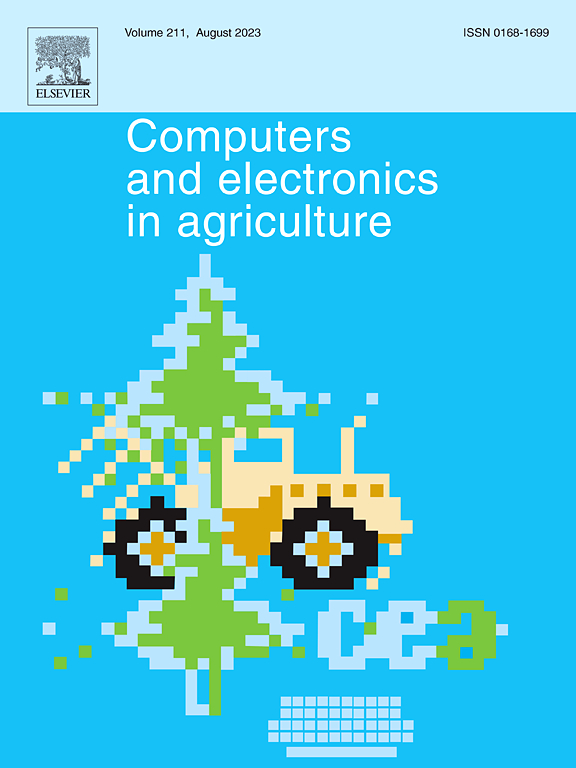电磁感应传感器评价与估算北方灰化壤土壤养分浓度
IF 8.9
1区 农林科学
Q1 AGRICULTURE, MULTIDISCIPLINARY
引用次数: 0
摘要
采用侵入式方法监测土壤性质的空间变异既复杂又耗时;然而,视电导率(ECa)的数字制图可以帮助研究浅层灰化土。我们假设利用电磁感应(EMI)传感器测量的土壤ECa可以用来估计土壤养分的时空变异性。本研究评估了ECa与土壤养分(铵- NH4+、硝- NO3−和正磷酸盐- PO43−)之间的关系,并建立了回归模型来预测这些养分。选择多线圈(MC)和多频率(MF)电磁干扰传感器来预测两种土地利用(草地- GL和农用地- AL)的营养成分。研究发现MC-EMI有显著的统计学响应(p值<;0.05),与土壤NH4+、NO3−和PO43−相关。尽管高度显著的相关性(p <;0.001),简单线性回归(SLR)模型表明,营养物质不能有效解释ECa的变化(低决定系数和高均方根误差)。多元线性回归(MLR)模型比单线性回归(SLR)模型更能反映各营养成分的饱和百分比和容重。基于MC EMI的MLR模型提供了比MF EMI传感器更好的养分预测,可能是由于传感器的采样深度差异和对土壤水分有效性的敏感性。研究还表明,如果土壤结构变异性和有机质含量保持暂时稳定,土壤含水量是ECa和养分变异性的主要驱动因素。这些结果表明,利用电磁干扰传感器可以快速评估灰化壤土壤养分的时空变化;需要进一步研究不同农艺处理及其对ECa和土壤养分关系的影响,以提高养分预测的准确性。本文章由计算机程序翻译,如有差异,请以英文原文为准。
Evaluation and estimation of boreal podzol soil nutrient concentrations using electromagnetic induction sensors
Monitoring the spatial variability of soil properties by intrusive methods can be complicated and time-consuming; nevertheless, digital mapping of apparent electrical conductivity (ECa) can assist in the investigation of shallow podzol soils. We hypothesized that ECa measured as a soil proxy using electromagnetic induction (EMI) sensors can be used to estimate spatiotemporal variability of soil nutrients. This study evaluated the relationship between ECa and selected soil nutrients (ammonium – NH4+, nitrate – NO3− and orthophosphate – PO43−) and developed regression models to predict those nutrients. Multi-coil (MC) and multi-frequency (MF) EMI sensors were selected to predict nutrients within two land uses (grassland – GL and agricultural land – AL). The study revealed that MC-EMI responded statistically significantly (p-value < 0.05) relative to MF-EMI to correlate with soil NH4+, NO3− and PO43−. Although highly significant correlations (p < 0.001) were observed between ECa values and nutrients, simple linear regression (SLR) models suggested nutrients did not effectively explain the ECa variations (low coefficient of determination and high root mean square error). Multiple linear regression (MLR) models were more effective than SLR in representing ECa with the inclusion of saturation percentage and bulk density with each nutrient. MC EMI-based MLR models provided better nutrient predictions than the MF EMI sensor, possibly due to the sensor’s sampling depth differences and sensitivity to moisture availability in the soil. The study also revealed that if textural variability and organic matter content remain temporally stable, soil water content acts as the main driving factor for both ECa and nutrient variability. While these results suggest the potential use of EMI sensors to rapidly assess the spatial and temporal variability of podzol soil nutrients; further research on different agronomic treatments and their effect on ECa and soil nutrient relation is required to improve nutrient prediction accuracy.
求助全文
通过发布文献求助,成功后即可免费获取论文全文。
去求助
来源期刊

Computers and Electronics in Agriculture
工程技术-计算机:跨学科应用
CiteScore
15.30
自引率
14.50%
发文量
800
审稿时长
62 days
期刊介绍:
Computers and Electronics in Agriculture provides international coverage of advancements in computer hardware, software, electronic instrumentation, and control systems applied to agricultural challenges. Encompassing agronomy, horticulture, forestry, aquaculture, and animal farming, the journal publishes original papers, reviews, and applications notes. It explores the use of computers and electronics in plant or animal agricultural production, covering topics like agricultural soils, water, pests, controlled environments, and waste. The scope extends to on-farm post-harvest operations and relevant technologies, including artificial intelligence, sensors, machine vision, robotics, networking, and simulation modeling. Its companion journal, Smart Agricultural Technology, continues the focus on smart applications in production agriculture.
 求助内容:
求助内容: 应助结果提醒方式:
应助结果提醒方式:


